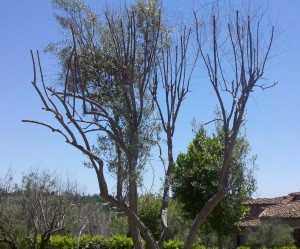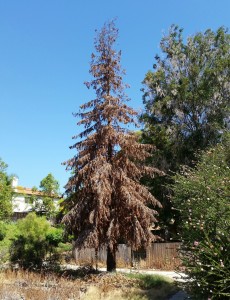What can homeowners do to keep their trees healthy during hotter, drier Summer months?
“While it’s impossible to keep every tree in good health in times of severe drought, taking a proactive approach for a prized or sentimental tree can prevent damage,” recommends Tchukki Andersen, CTSP, BCMA and staff arborist with the Tree Care industry Association. “A tree that is supported with good cultural practices, proactive monitoring for pests and disease, and responses to warning signs will have an increased chance of survival.”
Silent Suffering
“While it’s impossible to keep every tree in good health in times of severe drought, taking a proactive approach for a prized or sentimental tree can prevent damage,” recommends Tchukki Andersen, CTSP, BCMA and staff arborist with the Tree Care industry Association. “A tree that is supported with good cultural practices, proactive monitoring for pests and disease, and responses to warning signs will have an increased chance of survival.”
Opportunistic Pests and Diseases
This is when “opportunistic” pests make their move. Boring insects are thought to be drawn to the chemical and acoustic signals of stressed trees. The sound of the tree’s breaking water columns cues the borer to invade the tree and lay eggs. Andersen recommends applying a 3-inch layer of composted wood chip mulch on the ground over the root zone at least out to the drip line (the ground under the outer edge of the branch spread). This will hold moisture longer for stressed roots to access, and will provide a long-term nutritional source for the soil. Prized or important trees may be protected from wood-boring insects with spray or injection chemicals, but they should be treated before becoming drought-stressed.
Stressed trees are also vulnerable to fungal pathogens. Andersen notes that when a chemical change in the tree signals a weakened state, certain pathogens penetrate the bark and cambial zone (tissues responsible for secondary growth of stems and roots) with fan-like, leathery clumps, cutting off the tree’s water supply.
While all trees are at risk during long periods of drought, some are more susceptible to its effects.
 New transplants are highly vulnerable to drought stress, so supplemental watering for the first few years of establishment is necessary, to the extent that it is allowed. Trees already under stress, such as those on dry slopes, surrounded by pavement or improperly planted are at high risk of decline.
New transplants are highly vulnerable to drought stress, so supplemental watering for the first few years of establishment is necessary, to the extent that it is allowed. Trees already under stress, such as those on dry slopes, surrounded by pavement or improperly planted are at high risk of decline.
Watering trees deeply with soaker hoses or irrigation systems – as opposed to brief, surface watering – helps sustain trees. But with so many trees affected and a water ban in effect for much of California, Andersen recommends watering only those trees that you can help. How much water a home landscape needs depends upon its soil, sun and shade exposure, types of plants, irrigation system and local climate. How much water a tree requires is also dependent on its species. Applying the right amount of water, based on the local weather and the tree’s actual need, is the key to using water efficiently. Water trees and lawn separately, providing what each needs specifically.
What Else Can Be Done Under Local Water Restrictions?
- Mulch: 3-inch layer out to the drip line. (see more above)
- Reduce or eliminate the use of high-nitrogen fertilizers. High-nitrogen fertilizers contain salts that can damage stressed tree tissues. Also, nitrogen fertilizers push new tree growth, which can exhaust tree energy when stressed.
- Prune out only dead wood to reduce attacks by insect and disease pests. Do not remove live tree tissues until tree health improves.
- Prevent any further stress from construction activities, lawn herbicide applications, or foot-traffic over the root zone.
Outlook
The aftereffects of drought may last three to five years, with the strongest trees surviving. Trees have developed their own mechanisms for coping with these cycles, but some trees are on the brink of survival and could go either way. “If it means the difference between keeping a tree around for your lifetime or losing it in the next five years,” Andersen says, “it’s worth doing something about.”
